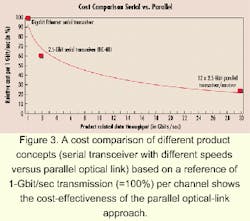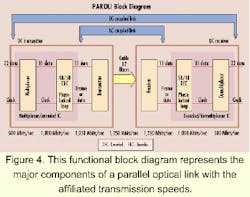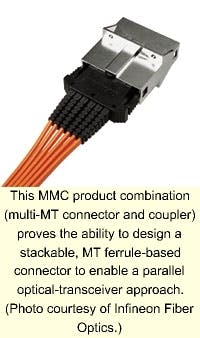Parallel optical links increase short-reach data throughput
MICHAEL KNEIER and KLAUS SCHULZ, Infineon Fiber Optics
The fiber-optic industry has recently seen significant demand for parallel optical devices that vendors are now scrambling to fulfill. Historically, the need for short-distance (<100 m), scalable, high-speed data interconnections among equipment in computing centers was widely satisfied with copper solutions, leaving optics to applications that required high data rates over long distances. Even though the first parallel-optical approaches and trials go back to the early 1990s (e.g., the Jitney-project, Optobus, PAROLI, and Polo-project), no products emerged that were proven in mass production. Instead, these early approaches led to such standards as HIPPI 6400 and the Scalable Coherent Interface (SCI) in Europe.But several factors have ignited the requirement for parallel optical links as well as the development of such important elements as vertical-cavity surface-emitting lasers (VCSELs), MT ferrules, and fiber-ribbon cables. Without a doubt, a milestone was reached last year with the shipment of parallel optical links in significant manufacturing volumes. Today, it's "full steam ahead" for parallel optics (see Figure 1).
As Dale Murray, a senior analyst at research firm ElectroniCast Corp., observed, "While expected for some time, optical backplanes are now becoming real. Very-high-performance switch fabrics already depend on intrashelf and intershelf parallel optical interconnections to create terabit switching solutions." Similarly, Jeremy Mills, head of research at ElectroniCast's European operation, stated, "We have seen tremendous growth in the use of parallel optical links and see a market exceeding $1 billion by 2003." So the market is real. Now, it is up to vendors to aggressively fill the pipeline.
So, what factors made the difference compared to five years ago in the rapid introduction of parallel optical links? One factor was the upswing in bandwidth demand-the well-known growth of Internet traffic. It is no longer surprising to read that the volume of Internet data now surpasses that of voice on a worldwide basis.The evolution of the Ethernet networking standard has proven to be a vivid example of rapid market change (see Figure 2). Can you recall the good old days of 10Base-T in the backbone? Five years later, when Fast Ethernet was hardly established, component vendors were holding Fast Ethernet prototypes in one hand while applying the other to Gigabit Ethernet development. Today, the imminent reality of 10-Gigabit Ethernet does not excite or surprise anyone.
So the calculation is as simple as this: If data throughput is increased tenfold at one end of your system, it has to be increased correspondingly at the other end. And the "other end" in this context means the
I/O type of applications that are the targets of parallel devices, e.g., board-to-board or rack - to-rack connections for tele communications switching systems, crossconnects, large routers, mainframe farms, or server clusters.
In this context, providing the necessary speeds is crucial for a technology to succeed. Even a technically excellent but low-speed optical product (in the range of some 100 megabits per second, "low" as judged from today's perspective), like Motorola's Optobus, disappeared from the market because it was suddenly out-paced by tremendous bandwidth needs.
This transition leads us to the second reason for massive deployment of parallel optical links, namely, technology.
The need for scalability has pushed copper solutions to their limits. Not only are there EMI, crosstalk, and power-consumption issues, but simply stated, space has become critical. And optics continues to show potential for ongoing miniaturization.In looking at optics in this context, it is reasonable to ask, why not implement the equivalent function of a parallel optical link with 12 serial Gigabit Ethernet transceivers? After all, these devices also have shown a reasonable price improvement over the last year. Yet, comparing the costs of the two options based on the overall data throughput, the picture looks somewhat different from what might be expected (see Figure 3).
In addition, limited board space favors the parallel optical approach. Equipment manufacturers want their system performance-not their board width-to be scalable. Even with small-form-factor (SFF) devices, which take just half the space of a standard duplex-SC 1x9 transceiver, customers would never accept the resulting inflationary consumption of their PC-board real estate that other options would require.
This environment, together with the cost-competitiveness of parallel optical solutions, and the extreme effort needed to make copper high-speed data-transmission reliable, opens the door for parallel optical links. The 12-channel PAROLI-module illustrates how parallel optical links work as well as the current performance parallel technology can achieve.
The electrical and optical parallel link consists of separate 12-channel transmitter (Tx) and 12-channel receiver (Rx) modules (see Figure 4). In HIPPI 6400 applications, the link operates synchronously. On the Tx side, 22 electrical channels operating at 500 Mbits/sec are multiplexed 2:1 down to 11 channels of 1,000 Mbits/sec each. The channels are then encoded by 4B/5B to 1,250 Mbits/sec per channel. This optical data rate is compliant with Gigabit Ethernet. Channel #12 is used for framing and synchronization.
The 11 Rx channels receive 1,250 Mbits/sec each. This data will be decoded and demultiplexed, resulting in 22 channels with 500 Mbits/sec on the electrical interface. Channel #12 is used for framing and synchronization. In Europe, this configuration also works for the standardized SCI.
The electrical interface on the Tx side permits a wide range of common-mode input voltage signals as low-voltage differential signaling (LVDS), LVPECL, and CML. The Rx output signaling can also be differentiated with two module options for LVDS and CML.
There are also modules for data rates up to 2.5 Gbits/sec per channel in production with identical footprints, but without the multiplexing/ demultiplexing or encoding/decoding function. In this configuration, the modules function in AC mode and fulfill the requirement for a high-speed interface with independent channels, as discussed within the Optical Internetworking Forum (OIF).In size and port density, the parallel optical-link module is similar to the small-form-factor pluggable (SFP) modules that are now in the product-definition stage. The mechanical design is based on VCSEL array technology, the optical port on MT technology, and the SMT capability on J-lead technology. The fit rate of the oxide-confined VCSEL is verified with a database of over 29 million hours, an operating time in the range of Fabry-Perot lasers. All the integrated circuits (ICs) were developed in-house utilizing B6HFC technology, featuring 3.3-V power supply and resulting in very-low-power consumption (Rx = 0.8 W; Tx = 1.2 W) while working at 2.5 Gbits/sec.
An AC-coupled version of the link at a data-rate of 2.5 Gbits/sec per channel was verified over a total link length of 130 m using a standard 62.5-micron fiber. With a new 50-micron fiber featuring a 2.5 times larger bandwidth, a link length of 300 m has been achieved.
Laser safety has been certified according to IEC 60825, class 3A, and FDA class1. When the updated IEC 60825 standard is released, the modules will meet class 1.
From the user perspective, transmission speed is not the only important parameter. In the rapidly growing fiber-optic marketplace, speed interpreted as "time to market" is as critical as data throughput. Parallel optical links have kept pace with this requirement. First-generation systems offered 1.25 Gbits/sec per channel three years ago; 2.5-Gbit/sec modules are available today that provide an overall throughput of 30 Gbits/sec per 0.375 inch2 (port density). Meanwhile, initial trials have shown the ability of 850-nm VCSELs to support transmission of 10 Gbits/sec per channel, which indicates what is waiting on the horizon.
In the context of 10-Gbit/sec transmission, it should be noted that while Synchronous Optical Network/Synchron ous Digital Hierarchy (SONET/SDH) has been leading the field through the implementation of OC-192 in long-haul applications, IEEE 802.3 and Fibre Channel are advancing with relaxed specifications to achieve cost-effective 10-Gbit/sec products for shorter link lengths. The most recent industrial standardization activities like the InfiniBand Trade Association and OIF are addressing these trends. While the OIF is relatively well known, the InfiniBand group may not be. The association is dedicated "to developing a new common I/O specification to deliver a channel-based, switched-fabric technology that the entire industry can adopt." Interested readers can find more information on the association at www.infi nibandta.org.
Meanwhile, the expected further cost reductions offered by new high-bandwidth fiber will also push the market by making long-distance and higher data-rate applications accessible. For customer-specific EMI requirements, the separate connection of a signal ground to the metal heat spreader and a chassis ground to an aperture inside the optical port similar to the adapters/ couplers can be easily implemented within parallel optical-link modules.Advances such as the SMC-connector (single MT connector) should prove valuable in different applications, as well. The shortest is 18-mm long and has the same functionality as a detachable pigtail; this configuration permits the parallel link modules to be mounted in the center of the host board. Another interesting use is to mount Tx and Rx modules in belly-to-belly position on a single board and connect them with one stacked SMC-duplex connector. This approach enables the connection of a pair of modules in such a way that Tx and Rx cannot be inverted.
All of these issues arose during the implementation of the first single Rx and Tx modules 15 years ago. A fully qualified, strain-relief SMC-connector is on its way through the TIA Working Group FO 6.3.4. The ballot circulates under the PN 4834. Besides Infineon, other major vendors such as Molex are supporting the SMC-connector family. For the active components, different sources are in place.
The potential offered by these connectors is significant. For example, in conjunction with a lead customer, an active optical-backplane solution has been developed that allows the connection of up to 720 optical channels in one 19-inch rack.
Since there is no hint that Moore's Law has become obsolete, the next performance jumps are predictable. One possible step, similar to the evolution of serial data transmission, is to integrate Tx and Rx in one package. There have been good reasons not to do so until today-for instance, the "natural" width of existing array connectors or avoidance of crosstalk through separate packaging. The chosen approach could be seen as a time-to-market enabler strategy.
But there are also some reasons to consider new concepts for future generations. To handle just one transceiver type of product in the equipment manufacturer's environment could bring an advantage over separate Tx and Rx modules. Making an MT ferrule-based connector act as a duplex or even a "six-plex" connector has been demonstrated successfully (see Photo).
Supported by the increasing availability of low-cost elements for 2.5-Gbit/sec solutions-such as higher-layer ICs in CMOS, proven design rules for FR-4 PCB-substrate, and compliant standard-board assembly processes-this data rate seems to be established as the most attractive speed at customer board I/Os.
The previously discussed parallel-link approach, particularly for 2.5 Gbits/sec per channel, shows excellent results for very-short-reach applications from the perspective of both data-channel density and cost per Gigabit per second. Therefore, we expect that the majority of parallel optical applications in the near future will adopt solutions at that data rate.
Michael Kneier is the director of strategic marketing at Infineon Fiber Optics (Berlin, Germany) and can be reached at michael. [email protected]. Klaus Schulz is the head of Infineon's Application, Innovation, and Standards Group and can be reached at [email protected].





